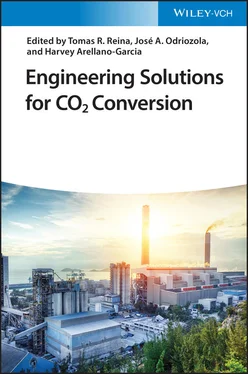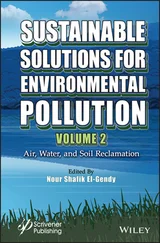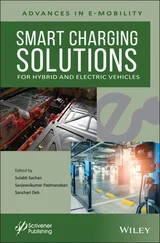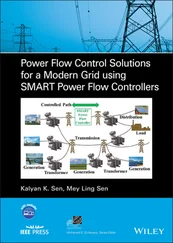3 Chapter 3 Figure 3.1 Gas transport through a membrane. Figure 3.2 Diffusion and solubility coefficient for different polyimides.... Figure 3.3 Upper bound correlation for (a) CO 2/CH 4separation and (b) CO 2/N 2 Figure 3.4 (a, b) Steps involved in the oxygen permeation through an oxygen ... Figure 3.5 Simplified process layouts for oxygen permeating membrane modules... Figure 3.6 Enthalpy and free energy of CO 2and H 2O reduction reactions and w... Figure 3.7 Schematic representation of the CO 2and Co‐electrolyzer systems.... Figure 3.8 (a) Representation of the four chemical steps. (b) Protonic membr... Figure 3.9 Co‐ionic catalytic membrane reactor.
4 Chapter 4 Figure 4.1 Overview of reaction pathways for CO 2toward different products. ... Figure 4.2 Reaction path for methanol synthesis (MS) by CO 2hydrogenation on... Figure 4.3 Proposed mechanism for dry reforming of methane on Ni catalyst.... Figure 4.4 (a) 2D contour map of the theoretical reduction potential in term...Figure 4.5 Cartoon of the neural network potential used to directly relax an...
5 Chapter 5Figure 5.1 World crude steel production in million tonnes reported by the Wo...Figure 5.2 Regional share of steel production in 2018.Figure 5.3 Stainless steel market diagram adapted from that published by the...Figure 5.4 Main actors and actions for the transition toward a zero‐emission...Figure 5.5 Power‐to‐X concepts overview.
6 Chapter 6Figure 6.1 Annual record of CO 2concentration in the atmosphere from 2013 to...Figure 6.2 Evolution of biogas production plants from 2010 to 2016.Figure 6.3 Some options for bio‐methane use after upgrading process.Figure 6.4 Main CCU technologies.Figure 6.5 Options for coupling biogas upgrading and CCU.Figure 6.6 CO 2capture from biogas and utilization in drink–food industry or...Figure 6.7 CO 2capture from biogas and precipitation with Ca 2+–Mg 2+‐...Figure 6.8 Membrane plus CO 2storage for food application.Figure 6.9 Biogas upgrading through membrane separation and methanation.Figure 6.10 Biogas upgrading via cryogenic methods and dry ice production.Figure 6.11 Biogas upgrading via cryogenic methods and supercritical CO 2pro...
7 Chapter 7Figure 7.1 Biological filters: (a) bioscrubber, (b) biofilter, and (c) biotr...Figure 7.2 The chemical structure of three typical siloxanes.Figure 7.3 Typical unit operations for the upgrading of biogas.Figure 7.4 Schematic representation of a typical water scrubbing system.Figure 7.5 Schematic representation of a typical water organic solvent scrub...Figure 7.6 Schematic representation of a typical chemical (amine) scrubbing ...Figure 7.7 Schematic representation of a typical pressure swing adsorption (...Figure 7.8 Schematic representation and operational principle of a tubular h...Figure 7.9 Schematic representation of a simple membrane upgrading system.Figure 7.10 Three alternative designs of membrane stages: (a) without biogas...Figure 7.11 Schematic representation of a simple three‐stage cryogenic bioga...
8 Chapter 8Figure 8.1 Concept for the storage of renewable energy in gas distribution s...Figure 8.2 Schematic of the intensified reverse water‐gas shift‐chemical loo...Figure 8.3 Flow sheet of a reforming process with optional configurations (d...Figure 8.4 TEM images of (a) CeO 2‐NRs, (b) CeO 2‐NCs, and (c) CeO 2‐NPs; high‐...
9 Chapter 9Figure 9.1 Some benefits of process intensification.Figure 9.2 Heat and mass transfer performance of various types of reactors....Figure 9.3 (a) Schematic representation of characteristic regimes observed i...Figure 9.4 Heat transfer characteristic data: (a) Illustrative representatio...Figure 9.5 (a) Schematic representation of the microchannel reactor includin...Figure 9.6 An overall schematic representation of the utilization of microch...Figure 9.7 (a) Representation of a single microchannel with a deposited cata...Figure 9.8 Schematic representation of in situ CH 4/O 2production as a propel...Figure 9.9 Overview of the transformation routes of CO 2into C 2+chemica...Scheme 9.1 Reaction of CO 2cycloaddition with epoxides.
10 Chapter 10Figure 10.1 Bulk chemicals based in CO 2hydrogenation reactions. Products wi...Figure 10.2 Renewable methanol production using renewable hydrogen and waste...Figure 10.3 Proposed CCU methanol plant for the techno‐economic evaluation....Figure 10.4 Strategy for the techno‐economic analysis.Figure 10.5 Evaluation of variable annual cost (M€ yr −1) and methanol ...Figure 10.6 Evaluation of payback period (PBP) and benefit–cost ratio (BCR) ...
11 Chapter 11Figure 11.1 Calculation of the temperature and pressure dependency of the co...Figure 11.2 Schematic illustration of the setup for the direct methanation. ...Figure 11.3 Performance as a function of the content of oxygen in synthetic ...Figure 11.4 Synthetic flue gas: temperature and CO 2conversion versus conten...Figure 11.5 Catalytic performance versus time. CO 2with 516 ppm SO 2is used....Figure 11.6 (a) Conversion of CO (empty circles) and CO 2(black circles) ver...Figure 11.7 Diagram for an oxyfuel CO 2circuit for an energy supply system w...Figure 11.8 Demand of gas flow of the Wankel engine, stable at 50 Hz, with r...Figure 11.9 Sketch of an integrated system applying electrolysis, direct flu...Figure 11.10 Setup of our high‐pressure methanol reactor with an integrated ...Figure 11.11 (a) The influence of N 2on the CO 2conversion rate (left scale)...
12 Chapter 12Figure 12.1 CO 2conversion as a function of temperature over (1) Au/CeO 2cat...Figure 12.2 Dependence of CO 2conversion on temperature for Au/TiO 2, TiO 2, a...Figure 12.3 Catalytic performance of Au/TiO 2and Au/Al 2O 3catalysts in RWGS ...Figure 12.4 Arrhenius plots for the Au/TiO 2and Au/Al 2O 3catalysts in RWGS r...Figure 12.5 (a) CO 2conversion and (b) CO selectivity as a function of react...Figure 12.6 Effect of reduction and oxygen pretreatment of Ru/CeO 2catalyst ...Figure 12.7 CO formation rate per catalyst weight and activation energy as a...Figure 12.8 Stability of 1 wt% Cu/β‐Mo 2C catalyst and the commercial 36 wt% ...Figure 12.9 CO selectivity and CH 4selectivity for Fe/Al 2O 3, Fe–Cu/Al 2O 3, Fe...Figure 12.10 Comparison of CO and CH 4selectivity on 0.5% and 10% Ni/SiO 2ca...Figure 12.11 Relative activity of Ni/CeO 2, Fe/CeO 2, and Fe‐incorporated Ni/C...Figure 12.12 Stable CO 2conversion was obtained over 3 wt% Ni/Ce–Zr–Ox catal...Figure 12.13 Proposed reaction mechanism of the RWGS reaction over Pt/CeO 2c...
13 Chapter 13Figure 13.1 Number of scientific publications containing the topic “electroc ...Figure 13.2 Scheme of a typical membrane electrode assembly used to carry ou...Figure 13.3 Scheme of a bipolar membrane‐based electrochemical cell used for...Figure 13.4 Scheme of the electrocatalyst developed by Cho and coworkers to ...Figure 13.5 Effect of the CO 2concentration on the reaction rates of (a) CO 2
14 Chapter 14Figure 14.1 A schematic view of solar‐driven CO 2‐to‐fuel strategy; a two‐ste...Figure 14.2 Schematic diagram showing the photocatalytic process for H 2prod...Figure 14.3 Tuning the selectivity of solar‐driven CO 2hydrogenation over Co...Figure 14.4 An overall schematic presentation of the sustainable energy econ...Figure 14.5 Proposed reaction pathway for CO 2electrocatalytic reduction on ...Figure 14.6 Schematic illustration depicts the several advantages of ultrath...
15 Chapter 15Figure 15.1 Graphic representation of core–shell and yolk–shell particles.Figure 15.2 (a) Publication metrics for papers published concerning sinterin...Figure 15.3 Volcano plot displaying the activity against binding energies of...Figure 15.4 Demonstration of the established equilibrium distance ( d M–S...Figure 15.5 Diagram of the conduction band (white squares) and valence band ...Figure 15.6 Diagram of how light interacts and refracts with solid, hollow, ...Figure 15.7 Schematic illustration of several YS variations: (a) standard si...Figure 15.8 Schematic illustration of how soft templating can achieve either...
Читать дальше












